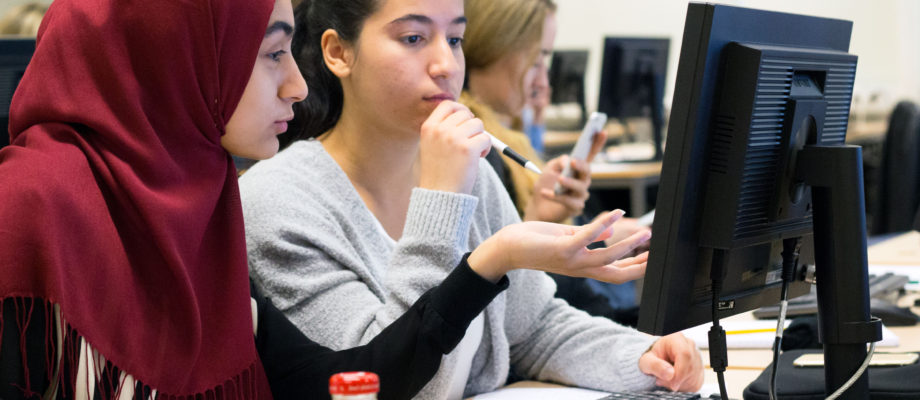EDUCATION. Thanks to a modern addition to the curriculum, fifth-semester medical students now learn about immunology by performing a virtual experiment on imaginary mice. The aim is to develop a new flu vaccine. The lab work is a new educational exercise developed by Susannah Leach during her time as a graduate student working within the university’s Basic Medicine Program.
A soft murmuring fills the computer lab as students work in pairs discussing in hushed tones how best to proceed in developing their flu vaccine. Israa Enabtawi and Zineb Chaabi enjoy the problem-based design of the exercise as well as the chance to apply the knowledge they acquired during the more theoretical lectures that preceded the lab work.
“It was a little scary at first—when our teacher explained that we were going to develop our own vaccine just before the lab work began—but now we both feel that the exercise is educational and also fun. A key aspect of the lab work is the process that leads to the vaccine: the contemplating and reasoning on which choices we need to make,” says Chaabi.
“The program gives good feedback and comments on the choices we make. The lab exercise is a lot more beneficial than just reading about vaccine development in a book,” Enabtawi believes. “We’re a little behind right now, but that’s actually because we’re having so much fun.”
An educational video game
The lab exercise was developed by Susannah Leach as part of the educational project work she undertook as a graduate student working within the Basic Medicine Program.
“Just reading up on influenza was a major undertaking in itself. After that, I needed to create three vaccine candidates with a foundation in real research for the students to choose between, and then invent and compile research results that would have existed if the experiments had been carried out in real life,” Leach explains.
Leach created the exercise inside the e-learning tool Articulate Storyline 2, and it works like an educational video game.
“I’ve tried to use game mechanisms and humor to gamify the lab exercise and create a little competition between the groups, which I think the students appreciate,” says Leach.
Well received
This is the second time that the virtual lab exercise has been conducted. The course evaluation after the first exercise from the spring were very positive—94 percent of students thought that the task met its objectives. Leach has since made a number of adjustments based on student feedback in the lead-up to this semester’s exercise.
“The exercise can produce different outcomes depending on which choices the students make. In the first version the students were eventually pointed towards the right vaccine, so, in reality, it wasn’t possible to make a mistake. Now it’s possible for the students to move ahead with a poor vaccine candidate and to see the consequences of their choices.”
Basic medicine meets clinical application
The Infection, Microbiology, and Immunity Course, of which the virtual lab work is a part, is comprehensive and involves teachers from three departments within Sahlgrenska Academy. The course includes both theory and practical work, and thus combines basic medicine with clinical application. Students studying the course are divided into a number of groups that rotate between the virtual lab, theory lectures, and practical training undertaken at the Clinic of Infectious Diseases at Sahlgrenska University Hospital’s Östra Hospital division.
According to Course Director Marianne Quiding-Järbrink, Leach’s lab exercise is a good example of the educational model known as peer learning.
“Peer learning involves the students acquiring knowledge jointly and learning from one another, resulting in a deeper, more effective learning process,” says Quiding-Järbrink and adds: “The lab work gives them a basic knowledge of vaccines and preclinical trials. The software gives the students the chance to conduct lab work that we could never have performed with them on real mice, since the experiments take at least three months to complete.”
During the research and planning stages of the new lab exercise, Leach received support from researchers working within UniVacFlu, a European research project aimed at creating a universal flu vaccine that is being coordinated from Sahlgrenska Academy. She also received financial support from the faculty in the form of educational project funds.
In late 2015, Leach defended her thesis on a new ETEC vaccine engineered by her supervisor, Ann-Mari Svennerholm. Since receiving her PhD, Leach has continued her work as a postdoc in Svennerholm’s group, and has recently begun her residency within clinical pharmacology at Sahlgrenska University Hospital.











